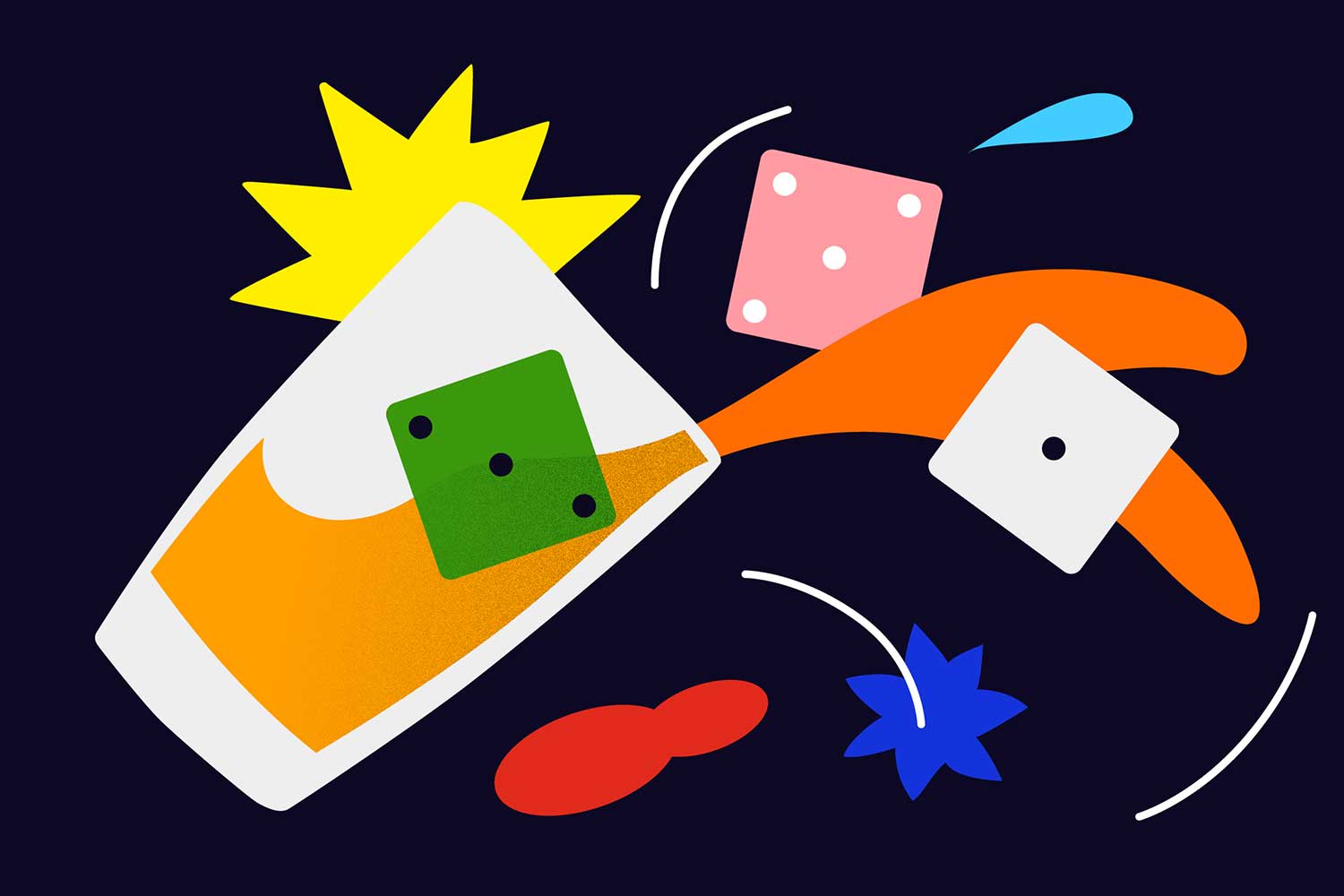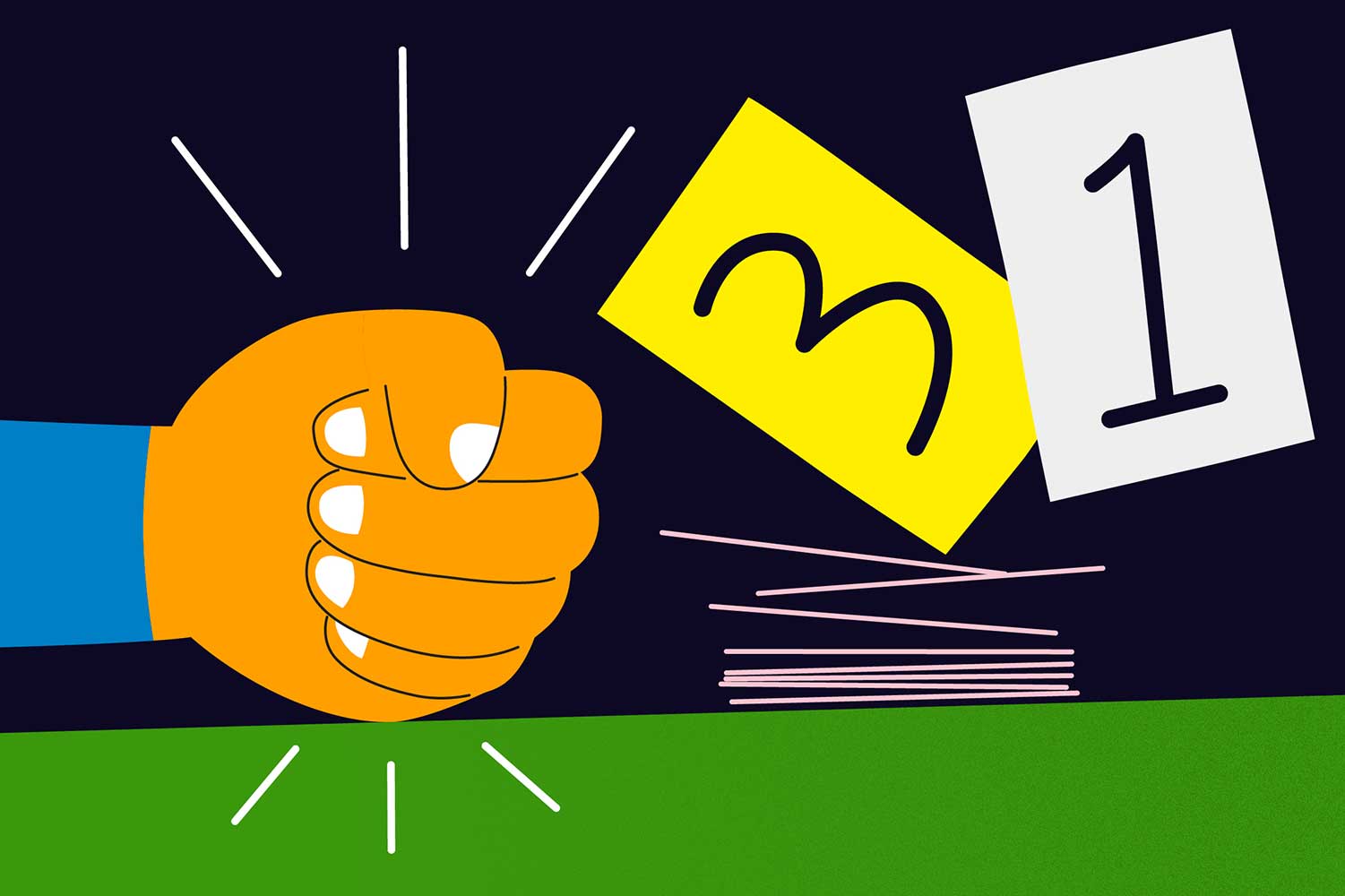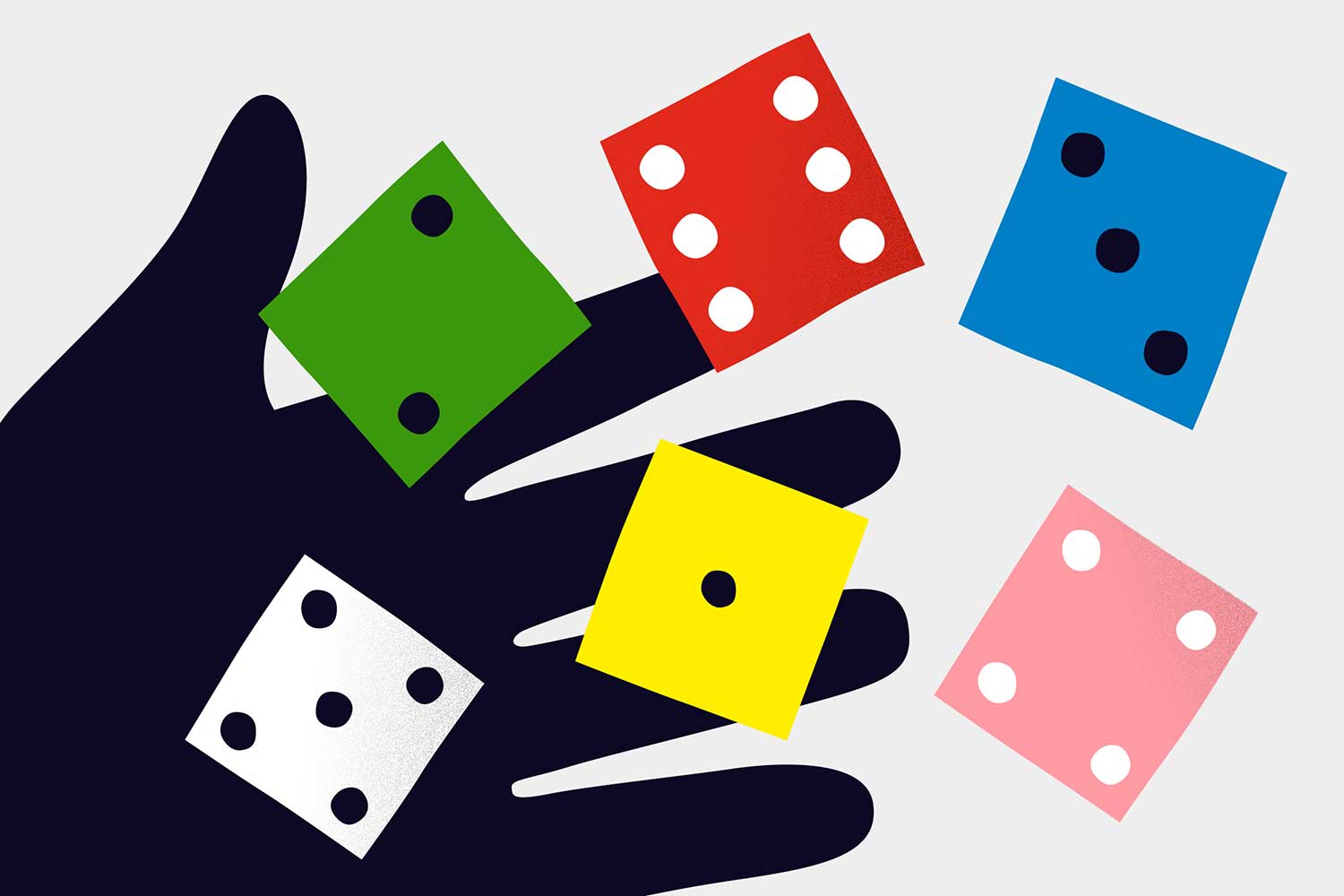Atelier
Dice, cards, and puns
Before we all develop premature cataracts from staring at our screens, our colleague Marie Charles has proposed a short games guide to help relieve our quarantine fatigue.
Text—Marie Charles Pelletier
Illustrations—Thaïla Khampo
Now that your bread is in the oven, perhaps it’s time to roll the dice and deal the cards, while talking about anything but the coronavirus.
I’m not going to teach you how to play bridge in this guide, but I’ve put together the rules for seven simple games that require very little in the way of materials, and can be adapted to various lockdown scenarios. Some are well known, others new, and each promises to brighten weekends home or at the cottage.
***

– Game 1 –
6 points (very easy)
Number of players
Two or more
Required materials
Three dice (everyone needs a set of COVID-19 lockdown dice)
A dice tray (helpful for throwing dice)
A cold beer (if you’re in a festive mood)
Object of the game
To keep your initial six points the longest.
Setup
Each player sits with their dice tray and three dice in front of them.
The play
- To determine who goes first, each player throws a die. The person with the highest number starts.
- Everyone begins with six points.
- Everyone places one die before them that serves solely as a points-marker, (beginning with the six side up).
- One by one, players throw two dice to get points. The highest of the two represents the tens and the second, the ones.
Example: if I throw a five and a two, my score is 52 and not 25. - The round is over once everyone has thrown their two dice and tallied their score.
- The player with the lowest score loses the round. That player loses one point and turns over the points-marker die.
- The last player to lose their six points is the grand winner.
Special cases
- If you throw two identical numbers, you multiply the score by one hundred
Example: if I throw two 2s, my score is 200. - If you throw two 1s, it’s “snake-eyes.” You automatically win the round.
Example of a round
Player one throws a 6 and a 4 (64).
Player two throws a 4 and a 3 (43).
Player three throws two 2s (200).
Conclusion: Player two loses the round and loses a point.

– Game 2 –
Clever Monkey
Number of players
Two
Note: it’s easy to play this game at a distance, via videochat.
Required materials
A deck of cards (one per person if you’re playing at a distance)
Object of the game
To try to respond correctly to the questions and guess the order of the cards
Setup
Each player has a flat surface and a deck of cards in front of them.
The play
- Each player starts with 24 points.
- Player one turns up four random cards and places them face up, keeping the rest of the pack hidden.
1st card
- Before turning over the next card from the deck (and placing it on top of the first of the four cards), player one asks the other player to guess whether it will be red or black
- If player two answers correctly, they move on to the next card.
- If player two does not answer correctly, they lose a point and have to start over.
2nd card
- Before turning over the card which will be placed on top of the second face-up card, player one asks player two to guess whether it will be higher or lower than the one already on the table.
- If player two guesses correctly, they advance to the next round..
- If player two answers incorrectly, they lose a point and start over from the beginning.
3rd card
- Before turning over the card which will go on top of the third face-up card, player one asks player two to guess whether or not it will be the same suit (hearts, diamonds, spades, clubs) as the face-up card.
- If player two guesses correctly, they advance to the next round.
- If player two answers incorrectly, they lose a point and start over from the beginning.
- At this stage, player two can decide to go double or nothing, by guessing the suit before the card is turned over. If they guess correctly, they win automatically. If they guess incorrectly, they lose two points and start over from the beginning.
4th card
- Before turning over the final card, which will go on top of the fourth face-up card, player one asks player two to guess whether it will be red or black.
- If player two guesses incorrectly, they lose a point and start over from the beginning.
- If player two guesses correctly, they have become the clever monkey. They can now calculate their points.
Next
- The roles are reversed and the game starts over.
- Player two turns over four new random cards.
- The round is over when both players have become clever monkeys.
- The game is over when one of the players has lost all 24 points.
The joker
- If one of the first four cards is a joker, that stage becomes a free pass. The player can pass directly to the next card without having to guess.
- If a joker is turned up during the guessing stages, one point is automatically deducted from the “dealer”. Another card must still be turned over in order to be able to guess on the following turn, but the player moves on automatically to the next card.

– Game 3 –
The Kid (for those in quarantine with multiple people)
Number of players
Two or more
Required materials
A deck of cards
Object of the game
Win 31 points
Card values
Aces are worth 11 points
Kings, queens, and jacks are worth 10 points
Other cards are worth their face value
The play
- The dealer shuffles and deals three cards to each player. They place the deck in the middle of the table and turn up the top card.
- The player to the left of the dealer starts the game.
- This player has the choice to pick up the upturned card and discard one of their own, or to take a card (facedown) from the top of the deck and discard one from their hand.
- Each player must have exactly three cards in hand at all times.
- Discarded cards are to be placed on the upturned card.
- The other players proceed in the same way until:
○ One player’s hand totals 31 points.
○ One player guesses that they have more points than the other players and calls the end of the round (at the risk of being wrong and automatically losing).
○ The last card from the deck is taken.
- The player whose hand totals 31 points, or who wants to end the round, must knock on the table before playing to announce the last turn for each player.
- If in the course of the last turn a player makes it to 31, that player wins the round. If not, the player who knocked is the winner, on the condition that their score is indeed the highest.
- If no one reaches a total of 31 by the time the deck is used up, the player whose score is closest to 31 wins the round.
- The winner of each round gets 1 point.
- The game is over when one player reaches 31 points / wins 31 rounds.

– Game 4 –
Sixth sense
Number of players
2 or more (in the same room)
Required materials
A bit of imagination
Object of the game
To guess the other player’s word
- Each player chooses an object in the room they are in.
- One by one, each person asks a yes or no question to the player of their choice.If there are more than two players, questions can be alternated between players.
- The object is to guess the other players’ words before your own is guessed.
- The person whose word is guessed last wins the round.
- To make the fun last, a game can be made up of 10 rounds.
Possible variations for those who want to play virtually: try guessing countries, foods, films, public figures, etc. Road trip lovers also know that this game is particularly fun to play in the car.

– Game 5 –
Dictionary
Number of players
Three or more (in the same place)
Required materials
Dictionary
Paper
Pencils
Object of the game
Guess the correct definition
Setup
A dictionary in the middle of the table and a piece of paper and a pencil in front of each player.
The play
- Each player starts with the number of points equal to two times the number of players.
Example: if there are three players, everyone begins with six points. - The players take turns being the professor.
- The professor opens the dictionary and chooses a rare word.
- The professor says the word out loud and writes down the definition on a piece of paper, concealing it from the other players.
- Each other player writes a fictional definition on a piece of paper and folds it.
- The professor collects all the definitions and reads them out loud, giving each one a number (i.e. definition 1, 2, 3).
- Each player votes for what they think is the correct definition (the object is not to vote for your own definition, but for the one that is most likely correct).
- If you don’t guess the correct definition, you lose a point.
- The last one to lose all their points wins and becomes Baudelaire.
Example of a round
- The professor chooses the word LAMPREY.
- Correct definition: N. An eel-like aquatic jawless vertebrate that has a sucker mouth with horny teeth and a rasping tongue.
- Fictional definition 1: N. Inflammatory skin condition particularly common on the African continent, transmitted by direct contact with the epidermis.
- Fictional definition 2: N. Tropical fruit found in Southeast Asia, with a stiff external layer, purple in colour, the inside of which is edible and resembles yellow plums.

– Game 6 –
La Boulette: The Name Game on Skype
Number of players
Minimum of four
If you are playing at a distance, videoconference or telephone both work
Required materials
A bowl (two if you’re playing at a distance)
Strips of paper
A pencil
A timer
A bottle of wine (optional)
Object of the game
Win the most points possible over the course of three rounds
Setup
Players have an empty bowl, their papers and their pencils in front of them
Prep
- Choose teams: if duos are at a distance, your partner must not be on the same side of the screen/phone as you
- Each player writes down 10 words on separate pieces of paper and folds them up.
- A tip for choosing words: open a book and choose 10 words at random.
- You can choose whether to accept proper nouns or not. To raise the level of difficulty, you can also use expressions.
- The players place all the pieces of paper into the bowl in front of them.
- One by one, the players have one minute to unfold the papers and have their teammate guess the maximum number of words.
- The game is composed of three rounds.
- Each round is over when all the words have been guessed.
The play
- Players 1 and 2 are on one side of the screen/phone; players 3 and 4 are on the other. 1 and 3 play against 2 and 4.
- Because it’s not possible to put all the pieces of paper into the same bowl, the game works with two “pools” of words. 1 and 2 share a bowl. Same thing for 3 and 4.
ROUND 1
- Player 1 has one minute to get player 3 to guess as many of the words as possible without ever using the word itself, or a word from the same family. You can’t mime or point, either.
Example: if the word is “fir,” I could say: “I am a conifer. I have needles. People decorate me at Christmas.” - When the minute’s up, it’s player 2’s turn to try and get player 4 to guess words.
- Next, it’s player 3’s turn to have player 1 guess, and player 4’s turn to have player 2 guess.
- Players take turns until there are no more papers in the bowl.
- When all the words in both bowls have been guessed, each team counts their points. The same papers are folded up again for round 2.
ROUND 2
- This time, only one word can be used to describe each word on the paper—which is why it’s important to listen closely in the first round!
Example: If the word is “fir,” I could say “needles.”
ROUND 3
- Players mime the words on the paper. No sound is allowed
Note: if a player is unable to guess the word, they can’t fold the paper back up and pull out another (Though some are more strict about this rule than others).

– Game 7 –
Old Gramps
Number of players
Two or more
Required materials
Six dice each (a dice tray is also a plus)
Paper and pencil for the scorekeeper (someone of an honest nature with a natural talent for mental calculations)
Object of the game
To try and keep your points
Setup
Each player has their dice tray and six dice in front of them.
To determine the order of play, each player throws a die.
The one with the highest number starts, and the others follow in descending order.
The play
- Each player starts with 30 points.
- The first player throws six dice.
- After each roll the player must choose to put at least one die aside, with the aim of getting the highest possible number of points, and rolling the rest again.
Note: you can’t separate dice with the same number. It might seem smart to keep three identical dice, but if the number on them isn’t that high, it’s better to keep just one die with a higher number.
- Once each player has rolled all their dice, points are added up
Example of a round:
-
- I roll my six dice. In my tray, I have: three 2s, one 6 and two 5s. I decide to keep the two 5s.
- I roll the remaining four dice again. I get: one 6, one 4 and two 3s. I keep the 6.
- I roll the remaining three. I get: one 5, one 3 and one 1. I keep the 5.
- I roll the remaining two. I get: two 4s. I don’t have a choice – I have to keep the two 4s.
- My total is 29 (5+5+6+5+4+4)
- The aim is to get more than 30 with the six dice (the maximum you could get is 36, since there are six dice).
- You lose points if your score is less than 30.
- Players must subtract the difference between 30 and that round’s obtained score from their total score (“capital”).
Example: If your score is 29, you lose 1 point and mark it down on the score pad. - If you get 30 exactly, you don’t subtract or add anything.
- If you get more than 30, you add to your capital.
- Getting a score above 30 also allows you to do an “old gramps.”
- The old gramps is a weapon to make your opponent lose points.
Example: If I get 32 points after rolling all the dice, I add two points to my capital and I do a #2 “old gramps.” I choose a scapegoat (when there are only two players, the choice is easy): the person from whom I’m going to take the total number of 2s thrown in my next tosses. I toss all six dice again, keeping only the 2s. I stop throwing when I don’t get any 2s. If I threw three 2s in total, I take six points away from my victim and mark it down on the score sheet. If I don’t get any 2s, no one loses (or wins) any points and it’s the next player’s turn. - The game is over for those who lose their 30 points.
- The last to lose their points is the winner.
- For someone to be eliminated, their capital has to be negative. If they are at 0, they can still play and hope to catch up. Once they reach -1, though, they’re out.
Marie Charles is the project manager at BESIDE Cabins and BESIDE Media. She spends the rest of her time getting lost (in the forest or in her thoughts). Marie Charles likes paradoxes and phở for breakfast. She is sensitive to her environment, which she takes pleasure in observing for long stretches of time—in nature as well as from her balcony on the rue Chambord.
Never Miss Another Issue
Two issues per year
25% OFF previous issues
Free Shipping in Canada